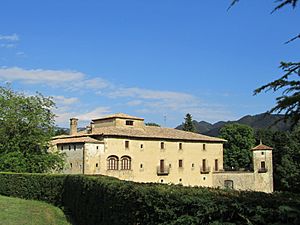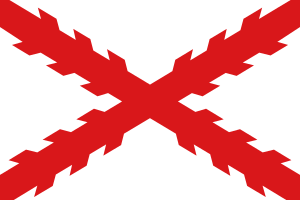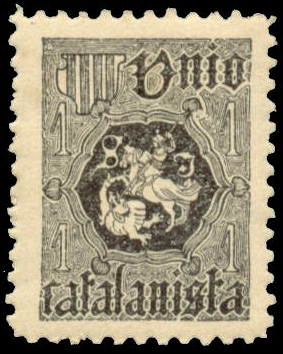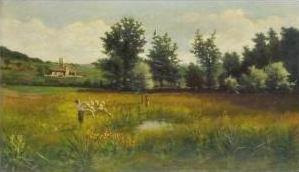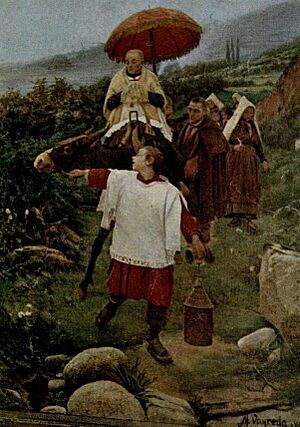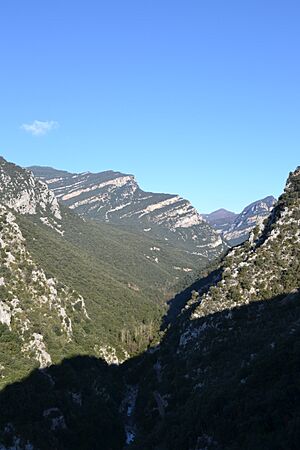Marian Vayreda i Vila facts for kids
Quick facts for kids
Marian Vayreda i Vila
|
|
|---|---|
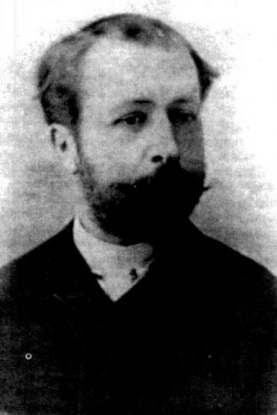 |
|
| Born |
Marian Vayreda i Vila
1853 |
| Died | 1903 Olot
|
| Nationality | Spanish |
| Occupation | painter, writer |
| Known for | his novels |
| Political party | Carlism, Catalanism |
Marian Vayreda i Vila (1853-1903) was a Spanish painter and writer from Catalonia. He was also a soldier and activist for the Carlist movement.
Vayreda is known as an important figure in the Catalan cultural renaissance of the late 1800s. His novel, La Punyalada, published in 1904, is considered one of the best works in Catalan literature.
Contents
Marian Vayreda's Early Life and Family
Marian Francesc Bartomeu Vayreda i Vila came from important Catalan families. His father's family was from Olot. During the First Carlist War, their home was burned down. This made Marian's grandfather move to Girona.
There, Marian's father, Francesc Vayreda i Busquets (1814-1870), met and married Maria Rosa Vila i Galí (1817-?). Her family, the Vila Cavaller, was very well-known. They owned several properties, including the famous Cavaller de Vidrà mansion.
In 1844, Marian's parents moved back to Olot. Marian's father was a "propietario rentista," meaning he owned land and lived off the rent. Marian had six siblings. Two of his brothers also became famous: Joaquím (1843-1894) was a painter, and Estanislau (1848-1901) was a botanist.
As a child, Marian spent a lot of time at the Cavaller de Vidrà estate. He later attended the Padres Escolapios college in Olot. He planned to study law in Barcelona. However, the Glorious Revolution in 1868 changed his plans. Marian decided to study art at l'Escola de Dibuix d'Olot instead.
Around 1870, he joined the Carlist movement. When the Third Carlist War began, he joined the Carlist troops. He fought in battles and was wounded. Before the Carlists lost, he escaped to France disguised as a farmer.
After a short time in Séte, Vayreda studied painting in Paris for two years. He took classes with Jean-Léon Gérôme. After a general pardon, he returned to Spain. He continued his art studies in Barcelona.
In 1878, he moved back to Olot. He helped start El Arte Cristiano, a successful workshop that made religious art. In 1883, Vayreda married Pilar Aulet Soler (1871-1928). They had seven children. Their son, Joaquím, became a writer and art critic.
Marian Vayreda's Political Views
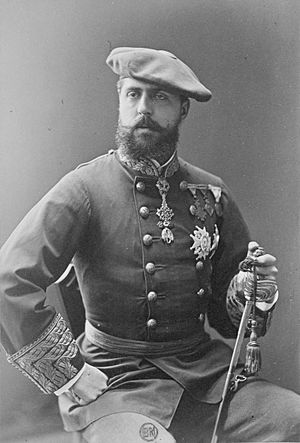
Marian Vayreda's mother's family was strongly Carlist for many years. Growing up at the Cavaller de Vidrà estate, Marian learned about their traditional beliefs. From age 15, he read La Esperanza, a newspaper that supported Carlism.
Carlism was a political movement in Spain. It supported a different branch of the royal family for the throne. It also wanted to keep traditional ways of life and regional laws, called fueros.
Vayreda joined the Carlist troops during the Third Carlist War. This was a civil war in Spain. Some historians say he joined because he believed in the Carlist defense of regional laws. The war deeply affected Marian. The chaos and defeat likely changed his strong youthful passion.
In the 1880s, Carlism was struggling. Vayreda joined the local Carlist club in Olot in 1895. He also became part of the local Carlist leadership. He said he joined to strengthen the regional ideas within the movement.
Vayreda wanted to lead the local Carlist party with a focus on regionalism. However, his ideas were not accepted by the provincial leaders. He complained that they ignored the regional goals of the Carlist program. He also felt their political direction was too much like "liberalism." In 1896, he left the Carlist club.
In his later years, Vayreda's connection to Carlism was not as strong. He preferred not to work with Carlist newspapers for his writings. He sometimes helped with Carlist election campaigns. He also wrote works that had Carlist themes.
Marian Vayreda and Catalan Identity
Vayreda said he joined Carlism because it defended traditional regional ways and had a regionalist spirit. After the war, his Carlist views became less strict. He focused more on regional identity, especially for Catalonia. This was called "traditionalist regionalism."
This shift was common for some Traditionalist activists in Spain. In the late 1880s, Vayreda joined others to form the local Centre Catalanista in Olot. This group focused on Catalan identity. He also supported their newspaper, El Olotense. Later, he connected with Unió Catalanista, another Catalanist group.
Vayreda's Catalan identity was deeply rooted in conservative, traditional, and Catholic ideas. He did not support Catalan political independence. He focused on Catalan culture. His idea of Catalonia was a spiritual place, like the "muntanya" (mountain). This idea was about the spirit of the land, religion, and history.
When Vayreda died, many Catalanist groups expressed their sadness. Historians often say Vayreda was at the crossroads of Carlism and Catalanism. Some believe he found a balance between the two. Others say his Catalanism was a form of Carlism. He described himself as a "traditionalist regionalist."
Marian Vayreda as a Painter
Vayreda painted throughout his adult life. Some believe he started focusing more on writing after his brother died in the mid-1890s. His first known painting is from 1876, and his last from 1901. He likely created hundreds of works, including sketches.
Most of his paintings are small, but his most famous ones are larger. He mainly used oil on canvas. He preferred to paint in his studio, using sketches and smaller works as guides.
Vayreda is known as a landscape painter or a costumbrista (someone who paints everyday life and customs). His works fall into four main types: landscapes, religious scenes, historical scenes, and customs. Often, he combined these themes.
His landscapes show the hilly Alt Garrotxa area. They are very detailed and accurate. They show sunny fields and wooded mountains, always looking perfect and peaceful. Some people think his landscapes are better than his brother Joaquím's. In many paintings, the landscape is the background for local rural scenes. These scenes always show local customs without any conflict.
Religious and historical scenes often feature medieval buildings, also from Alt Garrotxa. He paid close attention to details, sometimes adding his own creative touches. His historical paintings often show complex facts. They usually focus on medieval Spanish history. He also painted scenes from the Third Carlist War.
His religious works were often for private use or local churches. They show influences from Italian Renaissance art. People at the time admired their colors and light-and-shadow effects. Today, they are valued for their composition and context.
Vayreda was part of the Olot School of painters. This group shared a common vision for art. They believed art could help improve society. Some think this vision came from Carlism. Others see it as an effort to bring back Catalan traditions. Most agree that their main theme was a traditional view of the region. They used art to show how earth, religion, and history could stand against modern changes.
Marian Vayreda as a Writer
Vayreda first published in Spanish in 1888. But from 1890, he started writing short stories in Catalan. These stories were printed in regional newspapers. He sometimes used pen names. His stories, often set during the recent war, became popular. This encouraged him to enter local writing contests, where he was quite successful. He also wrote a few poems that were never published.
In 1898, he published his first major work, Recorts de la darrera carlinada. This book had 14 stories from the Third Carlist War. They were told in the first person and aimed to show the "essential truth" of the war. The stories were lively and showed the harsh reality of the conflict. While the book had some nostalgic Carlist tones, it did not try to push political ideas. Some modern critics compare Recorts to war stories by Hemingway. Many consider these short stories his best work.
Sanch nova (New Blood), published in 1900, was a novel set in Alt Garrotxa. It explored the conflict between modern liberal ideas and traditional values. The main character was a Catalan priest. People at the time called Sanch a "national novel" of Catalonia. They saw it as a symbol of the "renaissance" of Catalonia. Today, some see it as too focused on teaching and ideology. It is sometimes called an old-fashioned story that idealizes inner Catalonia. The "new blood" in the title actually refers to the old, established rural way of life.
La Punyalada (The Stab) was published after his death in 1904. Even though it might not have been completely finished, it is widely seen as his best work. This novel gave Vayreda an important place in Catalan literature. It is considered one of the best works ever written in Catalan. The story is set in the early 1840s. It tells a rural love story against the backdrop of life in Alt Garrotxa. The area is troubled by local bandits called trabucaires.
At first, La Punyalada was called a "historical novel." Now, scholars focus more on its psychological depth and hidden ideas. They note the excellent characters, interesting storytelling, and how nature acts like a character. Some believe the novel has a hidden political message. One character might represent the bad side of Carlism, and another its good side.
As a writer, Vayreda is not clearly linked to one specific literary group. Some thought he was a late follower of the Walter Scott style. Others noted his lack of romantic sadness and his focus on brutal reality. This put him closer to naturalist writers. Some see hints of modernism and symbolism in his work. However, most agree that Vayreda was a key figure in the Catalan literary Renaixença. He died just as he was reaching his full potential as a writer.
See also
 In Spanish: Marian Vayreda para niños
In Spanish: Marian Vayreda para niños
- Carlism
- Joaquim Vayreda
- Olot school
- Garrotxa
- Renaixença
- La puñalada
- Catalanismo
- El combregar a muntanya
- Josep Berga i Boix


